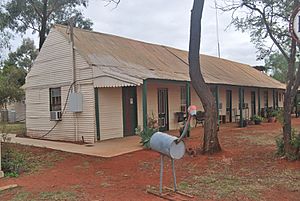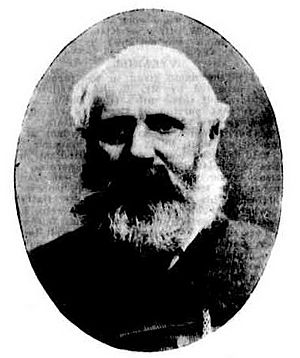Royal Mail Hotel, Hungerford facts for kids
Quick facts for kids Royal Mail Hotel, Hungerford |
|
|---|---|

Royal Mail Hotel, 2013
|
|
| Location | Archernar Street, Hungerford, Shire of Bulloo, Queensland, Australia |
| Design period | 1870s - 1890s (late 19th century) |
| Built | c. 1897 - |
| Official name: Royal Mail Hotel | |
| Type | state heritage (built) |
| Designated | 31 August 2001 |
| Reference no. | 601390 |
| Significant period | 1890s (fabric) 1897-ongoing (historical use) |
| Significant components | laundry / wash house, bathroom/bathhouse, residential accommodation - staff quarters |
| Lua error in Module:Location_map at line 420: attempt to index field 'wikibase' (a nil value). | |
The Royal Mail Hotel is a historic hotel located on Archernar Street in Hungerford, Queensland, Australia. It was built around 1897 and has been an important part of the town's history ever since. This hotel is so special that it was added to the Queensland Heritage Register on August 31, 2001, meaning it's officially protected for its historical value.
Contents
A Look Back in Time
The Royal Mail Hotel first opened its doors in 1874. This was just a year before Hungerford officially became a town. Hungerford is right on the border between Queensland and New South Wales. It sits on the east side of the Paroo River.
Why Hungerford Was Important
Hungerford was a key stop on an old stock route. This was a path used by drovers to move livestock, like cattle and sheep, from Queensland to markets in Victoria and South Australia. The hotel was also a customs post. This meant it was a place where taxes (duties) were collected on goods moving between the colonies.
In the 1850s, many people needed beef because of the Victorian gold rush. This made the stock route through Hungerford very busy. The Royal Mail Hotel was a perfect place for travelers to stop. It offered food and a place to sleep for people and their horses. You could also get a blacksmith to fix things, send messages, and find out about the road ahead. Hotels like this were vital for opening up new areas for settlement.
Mail and the Border
The first license for the Royal Mail Hotel was given to John George Cooke in 1874. He was also the local postmaster. The hotel's name, "Royal Mail," was very fitting. Many publicans (hotel owners) also handled mail over the years. The first post office in Hungerford started in 1876.
For many years, people weren't sure if Hungerford was in Queensland or New South Wales. This meant that the responsibility for mail delivery often switched between the two colonies. The border wasn't officially surveyed (mapped) until 1879-1880. When the survey was done, it showed that the Royal Mail Hotel was actually in Queensland! So, from 1880 onwards, the hotel's license was issued in Queensland.
Hungerford's Growth and Decline
Hungerford was one of 14 places along Queensland's borders that served as customs posts. These posts collected taxes on goods like wool. They also tried to stop smuggling, which was common because alcohol taxes were high in Queensland. These customs posts were no longer needed after Federation in 1901, when Australia became one country.
The town was named after Thomas Hungerford. He was a politician who camped in the area. People thought Hungerford would grow much bigger than it did. New South Wales even planned a "twin town" called "Berriwinnia" across the border, but it was never built.
From 1882, Cobb and Co ran weekly coach services between Hungerford and other towns like Eulo and Thargomindah. These coaches carried mail, goods, and passengers. Hotels like the Royal Mail were often used as stops where coaches could change horses and passengers could rest.
Henry Lawson's Visit
In 1892-1893, a famous Australian writer named Henry Lawson walked from Bourke to Hungerford and back. He found the area very tough. He even wrote a letter saying he was "finished with the bush." However, this trip inspired many of his early stories and poems. So, Hungerford played a part in shaping how Australians saw the bush in the late 1800s.
Lawson described Hungerford in one of his short stories:
The town is right on the Queensland border, and an interprovincial rabbit-proof fence - with rabbits on both sides of it - runs across the main street. Hungerford consists of two houses and a humpy in New South Wales, and five houses in Queensland. Characteristically enough, both the pubs are in Queensland. We got a glass of sour yeast at one and paid sixpence for it - we had asked for English ale.
The post office is in New South Wales, and the police barracks in Bananaland. The police cannot do anything if there's a row going on across the street in New South Wales except to send to Brisbane and have an extradition warrant applied for; and they do not do much if there's a row in Queensland. Most of the rows are across the border, where the pubs are.
The Hotel Today
After Federation, border customs posts were no longer needed. Also, the early 1900s were very dry. The Cobb & Co service to Hungerford stopped in 1904. By 1915, Hungerford was mostly bypassed by travelers.
The Royal Mail Hotel was sold in 1928. For most of the 20th century, it was the only hotel in Hungerford. It served local people and seasonal workers. In recent years, the town's population has been as low as 10 people. However, with the opening of nearby Currawinya National Park, more tourists are now visiting the hotel.
What the Hotel Looks Like
The Royal Mail Hotel is a single-story building. It has a timber (wood) frame and is covered with corrugated iron on its walls and roof. The building has two main sides that meet at a corner entrance. A section extends to the back, making the hotel shaped like a "U".
The main entrance is at the north-eastern corner. A wide roof (awning) is supported by timber posts and goes around both main sides of the building and the corner. The corner entrance leads into the bar area. The bar has a high ceiling and walls lined with pine boards. There's a brick chimney between the bar and what used to be the sitting room.
The original dining room is now used as living quarters for the hotel owners. Many of the walls and ceilings inside are lined with ripple iron. There are also three guest bedrooms.
Other Buildings
Around the hotel, there are other buildings also covered with corrugated iron. These include two bathrooms and a washhouse that isn't used anymore. The bathrooms have old-style fittings, including a claw-foot bath. There used to be staff quarters, but most of its outer covering is gone, and it's now used for storage.
Why It's a Heritage Site
The Royal Mail Hotel was added to the Queensland Heritage Register because it meets several important criteria:
- It shows how Queensland grew: The hotel helps us understand how towns developed in Queensland. It started as a stop for travelers on an important trade route. It also shows Hungerford's role as a border customs post before Australia became one country.
- It's rare: It's uncommon to find a coaching inn (a hotel that served horse-drawn coaches) that is still open for business in Queensland today.
- It helps us learn: The hotel can teach us a lot about how hotels operated in Queensland in the 1800s.
- It's a great example: It's a good example of a typical hotel found in a remote town. It still has old building techniques and hasn't changed much over the last 100 years.
- It looks good: The hotel's design, size, and materials make it an important part of Hungerford's look. It's a well-known landmark that the community values.
- It's important to the community: The hotel has a long and special connection with the people of Hungerford and the surrounding area. It has been the place for many social events.
- It's linked to famous people: The hotel and Hungerford are important because of their connection to the writer Henry Lawson. His writings about Hungerford helped shape how Australians thought about the bush in the late 1800s.




